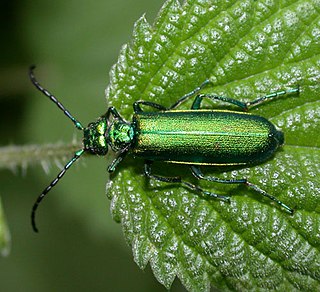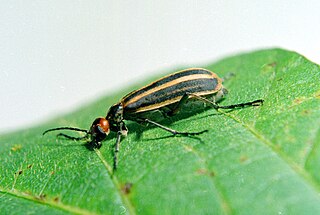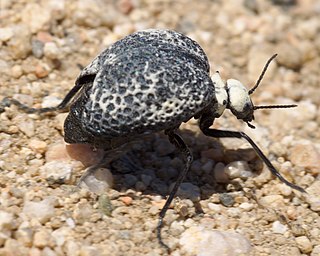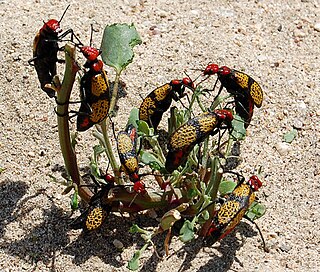
The Spanish fly is an aposematic emerald-green beetle in the blister beetle family (Meloidae). It is distributed across Eurasia.

Cantharidin is an odorless, colorless fatty substance of the terpenoid class, which is secreted by many species of blister beetles. It is a burn agent or a poison in large doses, but preparations containing it were historically used as aphrodisiacs. In its natural form, cantharidin is secreted by the male blister beetle, and given to the female as a copulatory gift during mating. Afterwards, the female beetle covers her eggs with it as a defense against predators.

Blister beetles are beetles of the family Meloidae, so called for their defensive secretion of a blistering agent, cantharidin. About 7,500 species are known worldwide. Many are conspicuous and some are aposematically colored, announcing their toxicity to would-be predators.
Economic entomology is a field of entomology, which involves the study of insects that benefit or harm humans, domestic animals, and crops. Insects that pose disadvantages are considered pests. Some species can cause indirect damage by spreading diseases, and these are termed as disease vectors. Those that are beneficial include those that are reared for food such as honey, substances such as lac or pigments, and for their role in pollinating crops and controlling pests.

Meloe is a genus of blister beetles commonly referred to as oil beetles. The name derives from their defensive strategy: when threatened by collectors or predators they release oily droplets of hemolymph from their joints. This fluid is bright orange and contains cantharidin, a poisonous chemical compound. Wiping the chemical on skin can cause blistering and painful swelling of the skin. This defensive strategy is not exclusive to this genus; all meloids possess and exude cantharidin upon threat.

Paederus dermatitis, medically known as dermatitis linearis, is a skin irritation resulting from contact with the hemolymph of certain rove beetles, a group that belongs to the insect order Coleoptera and the genus Paederus. Other local names given to Paederus dermatitis include spider-lick, whiplash dermatitis, and Nairobi fly dermatitis.

Epicauta is a genus of beetles in the blister beetle family, Meloidae. The genus was first scientifically described in 1834 by Pierre François Marie Auguste Dejean. Epicauta is distributed nearly worldwide, with species native to all continents except Australia and Antarctica. Surveys have found the genus to be particularly diverse in northern Arizona in the United States. Few species occur in the Arctic, with none farther north than the southern Northwest Territory of Canada.
Hycleus phaleratus, is a species of blister beetle found in China, Taiwan, Thailand, Indonesia, Nepal, India, Sri Lanka, and Pakistan. It is sometimes considered a problem in agricultural cultivation but has been used in traditional Chinese medicine. The species was formerly placed in the genus Mylabris.

Lytta nuttalli, or Nuttall's blister beetle, is a species of North American beetle first described in 1824 by Thomas_Say. The genus Lytta is from a Latin word suggesting madness The specific nuttallii recognizes the contributions of Thomas Nuttall, a contemporary of Say.

Epicauta vittata is a species of beetle in the family Meloidae, the blister beetles. It is native to eastern North America, including eastern Canada and the eastern United States. It is known commonly as the striped blister beetle and the old-fashioned potato beetle. It is known as an agricultural pest.

Ceroctis capensis, or spotted blister beetle, is diurnal and endemic to Southern Africa occurring in diverse habitats, and belonging to the Meloidae or Blister beetle family. It secretes a toxic liquid from its leg joints when roughly handled, blistering human skin. This species somewhat resembles Mylabris oculata, a member of the same family.

Meloinae is a subfamily of beetles in the family Meloidae. There are at least 330 described species in Meloinae.

Eupomphini is a tribe of blister beetles in the family Meloidae. There are about 7 genera and more than 20 described species in Eupomphini.

Tegrodera is a genus of beetles known as iron cross blister beetles and soldier blister beetles. They are in the family Meloidae. There are three described species in Tegrodera.
Tegrodera erosa is a species of blister beetle in the family Meloidae. It is found from California south to Sinaloa.

Megetra vittata is a species of blister beetle in the family Meloidae. It is found in North America. Like other blister beetles, megetra vittata excrete cantharidin, a toxic chemical, to defend itself from predators. Animals such as horses can fall ill and die from this toxin, as a result of eating many of these beetles, as they have been reported to get mixed in with their hay and other feed.
Tegrodera latecincta is a species of blister beetle in the family Meloidae. It is found in California.
Cordylospasta fulleri is a species of blister beetle in the family Meloidae. It is found in North America.

Cordylospasta is a genus of blister beetles in the family Meloidae. There are at least two described species in Cordylospasta.

Physomeloe corallifer is a species of blister beetle native to the Iberian Peninsula, it is the only recognised species in the genus Physomeloe.















